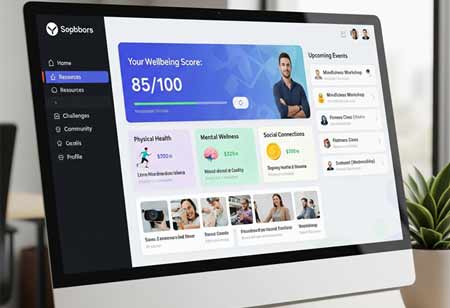THANK YOU FOR SUBSCRIBING
Be first to read the latest tech news, Industry Leader's Insights, and CIO interviews of medium and large enterprises exclusively from Hrtech Outlook
THANK YOU FOR SUBSCRIBING

By
HR Tech Outlook | Thursday, October 30, 2025
Stay ahead of the industry with exclusive feature stories on the top companies, expert insights and the latest news delivered straight to your inbox. Subscribe today.
Organizations face relentless pressure to hire faster, hire better, and reduce recruitment costs. Talent scarcity in high-demand roles, distributed teams, and rising expectations for candidate experience pushed recruiting beyond spreadsheets and job boards. AI recruiter solutions answer that pressure by automating repetitive tasks, surfacing the best-fit candidates, and delivering data-driven decisions that hiring teams can trust. The systems range from sourcing bots and résumé parsers to conversational interview assistants and predictive scoring engines that forecast candidate success.
Market Factors and Technology Implementation
Several market forces drive the adoption of AI recruiters, including talent shortages in tech and specialist roles, shrinking recruiter headcount budgets, the rise of remote and gig work, and the need for faster internal mobility. Companies feel revenue pressure when critical roles sit open, so hiring leaders prioritize time-to-fill and quality-of-hire metrics. They also face compliance demands, right-to-work checks, data protection rules, and increasingly strict non-discrimination standards that benefit from auditable, automated processes. Investors and HR leaders reward repeatable, measurable hiring programs, and AI recruiters deliver repeatability by codifying sourcing strategies, interview rubrics, and offer workflows.
Ingestion pipelines pull candidate data from job boards, corporate career pages, internal talent pools, social platforms, and employee referrals. Semantic search and vector embeddings rank candidates by conceptual similarity rather than keyword matches, enabling recruiters to find latent talent whose experience maps to job needs in non-obvious ways. ML models then score applicants on predicted performance, cultural fit, and retention risk using historical hiring outcomes, performance reviews, tenure data, and, where permitted, psychometric proxies.
Automation layers execute outreach at scale, including personalized email sequences, SMS nudges, and recruiter-assisted chatbots that screen availability and schedule interviews. Conversational AI conducts initial qualification using configurable scripts and captures structured responses that feed scoring models. Interview intelligence records interviews, transcribes responses, and applies sentiment and competency analytics to support calibrated interview feedback. Workflow orchestration automates offer approvals, background checks, and onboarding tasks, reducing manual handoffs and lag.
Latest Trends and High-Value Applications
AI recruiters evolved from simple résumé screeners into sophisticated talent orchestration platforms. The data improves predictive validity for technical and creative roles. Interview intelligence and hiring analytics help calibrate interviewers by surfacing bias signals, identifying differences in scoring patterns across demographics, and recommending standardized rubrics to level the evaluation field. Explainable AI becomes a procurement requirement; hiring teams demand transparent model outputs that explain why the system scored a candidate, providing features and data points that humans can inspect and verify.
Applications span sourcing, screening, interviewing, and post-hire optimization. Diversity, equity, and inclusion programs rely on anonymized shortlisting and fairness-aware ranking to expand pipelines. High-volume hiring scenarios, such as retail seasonal staffing and contact center ramp-ups, benefit from automated assessments and scheduling at scale. Cloud-native architectures enable these capabilities to be elastic and integrate identity, security, and compliance controls to maintain auditable trails. Vendors and in-house teams now combine HR domain knowledge with ML, natural language processing, and orchestration workflows to create end-to-end hiring stacks.
The market need for AI recruiters will grow as talent markets fragment across freelance, gig, and full-time ecosystems and as enterprises demand agility in reshaping skill mixes. Talent scarcity in the technology, healthcare, and green energy sectors will prompt organizations to adopt intelligent sourcing and internal mobility programs. Startups will continue to favor AI recruiters to scale quickly with lean teams, while large enterprises will rely on them to manage complexity across geographies and regulatory regimes. Vendors that combine trustworthy, explainable AI with seamless integrations, robust data governance, and recruiter-first user experiences will lead the market.
Addressing Bias and Ensuring Fairness
Explainability and human-in-the-loop controls ensure recruiters can override algorithmic recommendations and require multiple independent evidence sources before advancing candidates. Model performance and domain drift create headaches; skills required by roles evolve rapidly, and models degrade if they do not retrain on current hiring outcomes. AI recruiters transform talent acquisition from a reactive, labor-intensive function into a predictive and scalable capability that aligns workforce outcomes with business strategy. Businesses that pair AI with skilled recruiters, ethical frameworks, and continuous model governance will extract the most outstanding value and build fairer, more efficient hiring systems for the future.
Security and ethics issues arise in the context of interview analysis and automated decision-making. Sentiment analysis and facial micro-expression scoring are subject to scrutiny for potential misinterpretation. Many organizations limit NLP to competency-based coding and structured task scoring, and avoid personality inference from video unless it is validated and consent has been obtained. Industry bodies and regulators are increasingly providing guidance; proactive companies establish internal ethics boards and adopt ethical AI frameworks to govern their usage.
Recruiters reallocate time from screening to candidate relationship management, improving conversion rates and candidate experience. Predictive quality-of-hire models help identify candidates who perform better and stay longer, lowering early attrition and the recruitment cost-per-hire. Companies scale talent operations globally without linear headcount growth in recruiting teams. For candidates, AI enhances responsiveness through fast screening and transparent feedback, as platforms provide clear next steps and human contact points.



